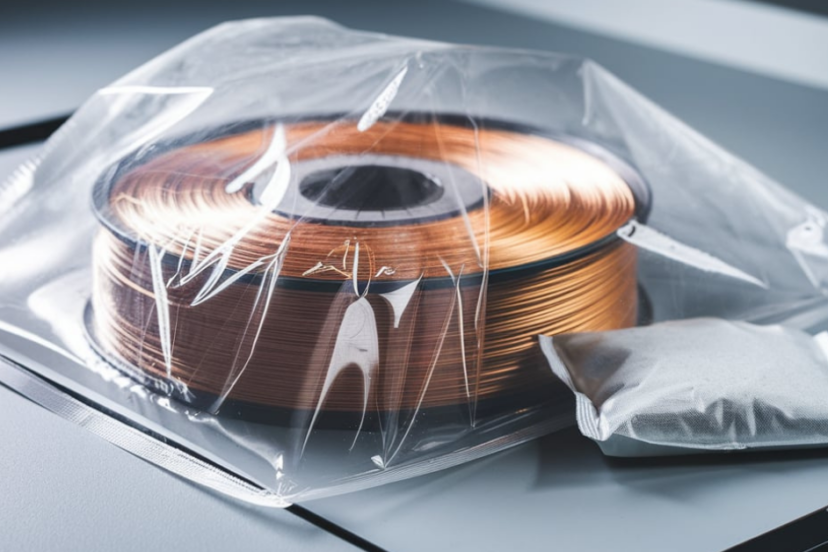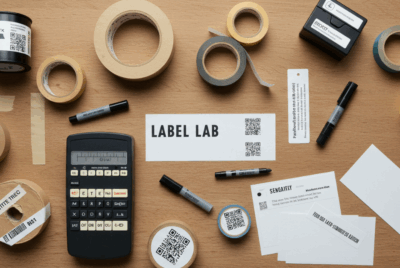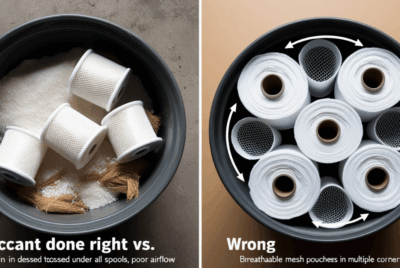Why Vacuum-Sealed Bags Are the Best Option for Storing 3D Filament.
1. The Impact of Moisture on 3D Filament
- Moisture and Filament Quality: Explain how 3D filament absorbs moisture from the air and the impact this has on print quality. Moisture can lead to issues like bubbling, poor adhesion, stringing, and weakened prints.
- Examples of Filament Types Prone to Moisture: Discuss how certain materials like Nylon, TPU, and ABS are more sensitive to moisture absorption.
2. What Are Vacuum-Sealed Bags?
- Definition: Define what vacuum-sealed bags are and how they work. These bags use a vacuum pump to remove air from the bag, creating a tight, airless environment.
- How They Work: Briefly explain the mechanism — the bag removes air, which significantly reduces the chance of moisture entering or accumulating inside.
- Comparison to Other Storage Methods: Compare vacuum-sealed bags to other common filament storage solutions like plastic bins, dry boxes, or silica gel bags.
3. Advantages of Using Vacuum-Sealed Bags for Filament Storage
- Protection from Moisture: Highlight how vacuum-sealed bags protect filament from humidity and moisture, extending the filament’s shelf life and ensuring print quality.
- Consistency in Print Quality: Discuss how preventing moisture absorption leads to more consistent prints, with fewer defects like stringing, popping, or inconsistent extrusion.
- Space Efficiency: Vacuum-sealed bags reduce the size of filament rolls, making them easier to store. This is especially helpful for those with limited storage space.
- Reusability: Explain that vacuum-sealed bags are reusable, making them an environmentally friendly and cost-effective storage solution.
4. How to Use Vacuum-Sealed Bags for Filament Storage
- Step-by-Step Process: Provide simple instructions on how to store filament using vacuum-sealed bags. Include steps like:
- Place the filament spool in the bag.
- Use a vacuum sealer to remove air and seal the bag.
- Optionally, add desiccants or moisture-absorbing packets to the bag for extra protection.
- Storage Tips: Recommend storing the vacuum-sealed bags in a cool, dry place to further reduce the risk of humidity and temperature fluctuations.
5. Vacuum-Sealed Bags vs. Other Storage Options
- Dry Boxes: Compare vacuum-sealed bags to dry boxes, which typically use a fan and desiccants to reduce humidity. Highlight that vacuum-sealed bags provide a more airtight seal.
- Silica Gel Packs: Discuss how silica gel can help absorb moisture but isn’t as effective in long-term storage compared to vacuum-sealed bags.
- Plastic Bins: Contrast vacuum-sealed bags with plastic bins, which often allow humidity to seep in over time, especially if not properly sealed.
6. Cost-Effectiveness of Vacuum-Sealed Bags
- Affordable Solution: Explain that vacuum-sealed bags are an affordable option compared to purchasing dedicated dry boxes or desiccant-filled storage units.
- Long-Term Savings: Discuss how vacuum-sealed bags protect filament and prevent waste, making them a wise investment for anyone serious about 3D printing.
7. Common Mistakes and Tips for Proper Use
- Avoid Over-Sealing: Mention that over-sealing the bag can sometimes create a vacuum that is too tight, making it difficult to open or remove filament.
- Check Seal Regularly: Suggest checking the bag’s seal every few months to ensure the filament remains protected, as even the best bags can sometimes lose their vacuum over time.
- Adding Desiccants: Recommend adding silica gel or other moisture-absorbing desiccants to enhance moisture control.
8. Conclusion
- Summary: Recap the advantages of using vacuum-sealed bags for filament storage, emphasizing their moisture protection, space efficiency, and cost-effectiveness.
FAQs
- How long can I store filament in a vacuum-sealed bag?
Filament can be stored in a vacuum-sealed bag for months to years, depending on the quality of the bag and storage conditions. - Do vacuum-sealed bags work for all types of filament?
Yes, vacuum-sealed bags work well for all types of filament, especially moisture-sensitive ones like Nylon, TPU, and ABS. - Can I reuse vacuum-sealed bags?
Yes, vacuum-sealed bags are reusable, which makes them a cost-effective and environmentally friendly option. - Do I need to add desiccants when using vacuum-sealed bags?
While vacuum-sealing helps protect filament from moisture, adding desiccants is recommended for extra moisture control, especially for long-term storage. - Can vacuum-sealed bags damage filament?
No, vacuum-sealed bags will not damage filament if used correctly. Ensure the bag isn’t sealed too tightly and that it is stored in a cool, dry place to protect the filament.




